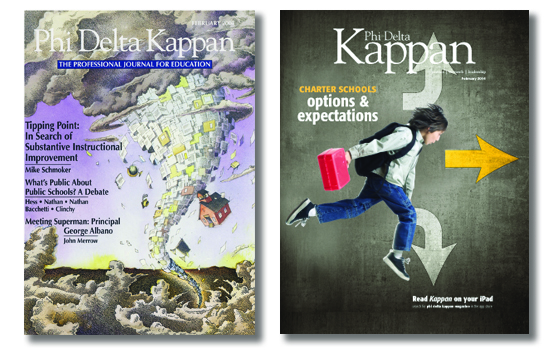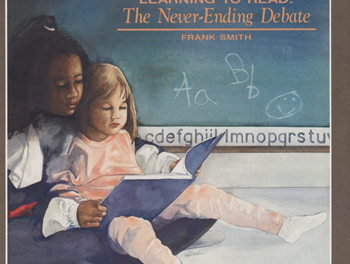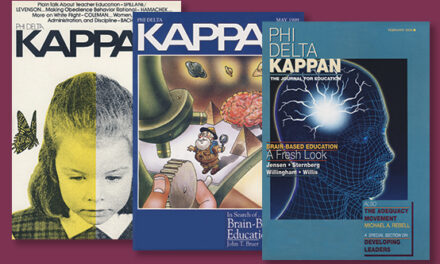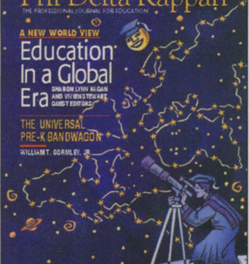Across the decades, many Kappan authors have asked — and attempted to answer — big questions about the nature and purpose of public schools.
In the October 1931 issue of Kappan, Daniel Eginton, a researcher at the Connecticut State Board of Education, noted that in the 19th century, most Americans came to believe that they could not rely upon church-run schools to create the literate citizenry that our democracy requires, and that “schools must be supported from public taxation; be non-sectarian, free, compulsory, and universal; and, that education is the function of the state” (p. 66).
However, added Eginton, while advocates made a clear case for shifting educational authority from church to state, they never defined precisely how that state authority ought to function. “The time has come,” he argued,
[for] a re-interpretation of this fundamental principle of American education to see what are the advantages of state control of education and what are its disadvantages. Also, to see what phases of the educational program may be controlled best by the central authority and which ones, by the nature of the educative process, must be left to the professionally trained classroom teacher. (p. 68)
By the end of his article, Eginton was unable to reach any firm conclusions, other than to reiterate the need for wise leaders to tackle long-deferred questions about the public schools’ proper form of governance, their relationship to private and parochial schools, and the best way to protect local decision making within complex modern bureaucracies. (“Would that another Horace Mann would appear,” wrote Eginton, “to guide us out of the present dilemma!”)
Education in a democratic society
Since 1931, Kappan authors have reexamined the function of state-sponsored education numerous times, some choosing to question its logic and others grounding themselves firmly in the democratic mission that, as Eginton noted, motivated the very founding of the public schools in the 19th century.
Writing in the midst of the second World War, for instance, Harl Douglas (“The basic responsibility of public education,” Sept. 1942) wrote that
The policy of supporting public schools by general taxation according to ability to pay is logical only for an educational system which has as its principal objective some important contribution to society, to the welfare of all of us, and not merely to serve those who have children in the public schools. (p. 4)
Although schools do have other purposes, such as preparation for higher education and work, Douglas suggested that these purposes must remain secondary to educating students to be effective participants in our democratic society.
More than 50 years later, Nel Noddings (“Renewing democracy in schools,” April 1999) expanded upon this premise, suggesting not only that tax-supported schools are basic to our democracy but that students must be given opportunities to discuss political ideas if they are to “get about” in an environment of political freedom (p. 580). Several Kappan authors have gone still further along these lines, noting that schools themselves must be democratic if students are to learn to live in a democratic society. For instance, in “Schools for scandal: The Bill of Rights and public education” (December 1969), Ira Glasser argued that students are entitled to the full protections of the Bill of Rights. A few years later, though, Frank Brown (“Forced schooling,” January 1973) took this argument so far as to distance himself from the very premise that democracy requires state-sponsored education; compulsory schooling itself, he concluded, is an infringement on student rights.
Governing the public schools
Like Eginton, many other Kappan authors have sought to resolve the tension between the bureaucratic nature of modern school systems and the public’s involvement in local governance. In June 1961, Clifford Hooker (“To create an enduring society”) observed that allowing small school districts to govern their schools is both inefficient and contributes to a sense of isolationism, the opposite of what is needed in a global leader like the United States. Just the opposite, argued Phillip Schlechty, nearly 50 years later (“No community left behind,” April 2008): He recommended limiting federal and state involvement in public schools and returning control to local communities. But at the same time, added Schlechty, local communities will have to confront the “unfortunate tendency to equate parents with the public and to substitute parental engagement with the schools for public engagement with education” (p. 562). Everyone has an interest in deciding what goes on in the public schools, he explained; governance isn’t just for parents with kids enrolled in the school system.
In a June 1997 issue devoted to the theme “Engaging the public with its schools,” David Mathews suggested that schools had become too disconnected from the public that they serve. In his article “The lack of a public for public schools,” Mathews posited that “Restoring legitimacy to the public school system will require rewriting the compact with the public, which will, in turn, require a public that can define its interests,” and went on to ask, “What are the various interests of the public? We never decide them all together or all at once. We make our choices community by community and issue by issue” (p. 741). (Mathews returned to the same thesis in April 2008 in “The public and public schools: The coproduction of education.”)
Funding which schools?
Much of the discussion about the nature of public schooling has had to do with funding. This goes back as far as February 1948 when, in an article titled “Financing our public schools,” Earle Liggitt argued that “In the practice of universal taxation for school support, our nation is unique among the nations of the world” (p. 271).
Many of our authors have questioned whether and how much of our tax funds can be spent on nonpublic schools. Early on, this question tended to arise mostly in relation to religious schools. For instance, Kappan’s April 1955 issue on religion in education included an article by Irwin Widen titled “Federal aid and the church school issue,” which reported that PDK’s National Commission on the Support of Public Education had taken the position that tax funds should not support “sectarian or other nonpublic schools” (p. 271).
In December 1963, Kappan featured articles looking at the funding of religious schooling from Catholic, Protestant, Jewish, and independent perspectives. In “America’s largest nonpublic system: Administration and financing of Catholic schools,” Msgr. William McManus extolled the benefits of Catholic education and lamented how costly it is for parents. He then went on to describe the Catholic position on funding of parochial schools:
A government which collects school taxes from all citizens is obliged by distributive justice to appropriate an equitable share to all qualified schools rendering a public service. From this teaching it follows that federal and state laws forbidding tax aid to Catholic and other qualified nonpublic schools are unjust and ought to be repealed or amended. (p. 135)
In “A rapidly growing movement: The Jewish day schools,” Joseph Kaminetsky described the benefits of a Jewish day school education to all in the community and the struggles of these schools to receive adequate funding, closing the article with an endorsement of the idea that they should receive some government funding. In “The Protestant schools: Purposes, programs, financing,” on the other hand, Arthur Ahlschwede explained that Protestants generally support schooling because of their interest in biblical literacy among congregants. However, because of the diversity of belief and practice among Protestant churches, he was unable to present a Protestant position on the government’s relationship to Protestant schools.
But the debate certainly hasn’t been limited to the use of tax funds for religious schooling. In his June 1962 article “Federal aid for nonpublic education: Design for decimating public schools,” Daniel Levine laid out an argument that will seem familiar to those who follow today’s debates around vouchers and other choice initiatives: Levine excoriates Milton Friedman’s proposal that the government allocate money to parents for them to spend at a school of their choice. Parents who could afford it, Levine said, would give not only those government funds but additional funds to their chosen schools. And as a result,
Many schools would attempt to gain the patronage of wealthier persons by strictly excluding “undesirable” clientele. This practice already exists, of course; but it would become commonplace if all schools were operated in a competitive market situation. Such schools are no longer nonpublic schools; rather, they are unpublic or anti-public schools. (p. 388)
In the decades since then, Kappan’s authors have tended to focus on private school choice in general, rather than on the use of public funds to send children to religious schools in particular. In Kappan’s December 1978, issue, for example, Senators Daniel Patrick Moynihan and Ernest Hollings made their cases for and against tuition tax credits (in response to a bill, introduced by Moynihan and Bob Packwood, that would have supported such tax credits; it was ultimately defeated by a 56-41 vote). Nine months later, in September 1979, we published a set of articles dissecting a voucher proposal in California. And since that time, the debate on public funding for private schools hasn’t evolved so much as it has moved back and forth along a well-worn groove, some authors supporting such options and others decrying them as a betrayal of fundamental principles.
Public school choice and charters
In addition to providing a forum for U.S. senators to debate tax credits, the December 1978 issue also introduced a new wrinkle to Kappan’s coverage of school choice. In the article, “If not public choice, then private escape,” Evans Clinchy and Elisabeth Allen Cody acknowledged that opponents of tax credit and voucher plans had valid concerns, but still, they wondered, why are private schools so attractive to so many parents? Perhaps parents were frustrated by school bureaucracy, and maybe they understood that not all students benefit from the same type of school. Recognizing this, the authors said, could
raise the intriguing possibility that a system of diversity and choice within the public schools might work not simply to stem flight from the public schools but actually to begin to reverse that trend. If such turns out to be the case, the threat of tuition tax credits, voucher plans, and the possible collapse of public education could turn out to be not an earthquake but merely a timely incentive to encourage us to figure out better ways of operating public school systems. (p. 273)
At this point, articles about public school choice, often focusing on charter schools, began regularly appearing in Kappan. Indeed, the September 1996 issue featured a special section on charter schools. In his introduction (“Possibilities, problems, and progress: Early lessons from the charter movement”), guest editor Joe Nathan stated that
The charter school movement brings together four powerful concepts: freedom and choice for families, entrepreneurial opportunities for educators, explicit accountability for schools, and thoughtful, fair competition for public school districts. For many advocates, the charter public school movement is an expansion of opportunity, similar to that proposed by people like Susan B. Anthony, Dr. Martin Luther King, Jr., and Cesar Chavez. (p. 18)
By 2014, when Kappan again devoted a special issue to charters (“Charter schools: Options and expectations”), the ecumenical optimism of 1996 had given way to a bitter fight between pro- and anti-charter camps, prompting one author, Anne Foster, to declare that it is “Time for détente between charter and traditional public schools.” She summed up the debate in this way:
The proliferation of charter schools, along with the accelerated talk about failing public schools, has become a flashpoint in the current battle for school reform. Charter school proponents are pushing for more charter schools, arguing that they are superior to regular public schools and that they can serve challenged students better. Proponents of traditional public schools argue that they’re educating 95% of the nation’s children and that any funding lost to charter schools makes it just that much more difficult. (pp. 20-21)
Back to fundamental questions
In these pages, questions about the meaning and mission of public schooling have often come up in the context of debates about specific policy proposals, having to do with tax credits, vouchers, and charters. But, as in the current issue, we have also asked authors to step back and examine the underlying principles on which our schools were founded. For instance, nearly 15 years ago, in the February 2004 issue, we invited Rick Hess, Linda Nathan, Joe Nathan, Ray Bacchetti, and Evans Clinchy to debate the question, “What’s public about public schools?” In his opening essay, Hess suggested that public has become a dangerously fuzzy term, used by defenders of traditional school systems to attack those who call for new ways of organizing and providing education. Public schools, argued Hess, should be defined by their core commitments (to prepare students for productive citizenship, to guarantee all young people access to a good education) and not by formal characteristics such as who governs or operates them.
Fast forward to the present issue — after another decade-and-a-half of charter school growth, the expansion of voucher and tax credit programs, the withering of the middle class, and the weakening of our belief in a common American identity — and the question of what we mean by “public” schools, has only become more urgent, and more complex, than ever.
Citation: Preston, T. (2018). A LOOK BACK: How Kappan has discussed the meaning and mission of public schooling. Phi Delta Kappan, 100 (3), 5-7.
ABOUT THE AUTHOR

Teresa Preston
Teresa Preston is editor-in-chief of Phi Delta Kappan and director of publications for PDK International, Arlington, VA.
Visit their website at: https://pdkintl.org/









